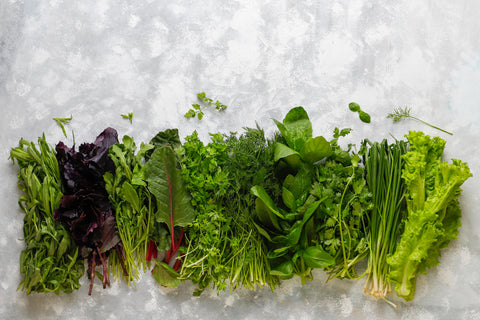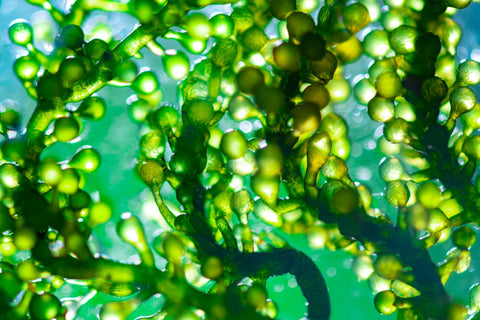Moringa oleifera, called the “Miracle Tree”, is one of nature’s most healthy and nutritious foods. There are countless studies that describe the benefits of moringa leaves, one of the most potent plants in the world.
Moringa leave is an exceptionally high source of chlorophyll, green pigment regarded as one of the most beneficial energy-boosting and health-enhancing natural substances known. Some sources suggest dried moringa leaves may have three times the chlorophyll of wheatgrass!
The leaves of Moringa oleifera tree are extremely nutrient-dense, providing essential amino acids and highly bio-available vitamins and minerals, especially Calcium, Zinc, Vitamins A, Vitamins B or Vitamins C. It is also an important source of natural Iron that helps to increase energy and regenerate red blood cells to prevent anaemia.
Moringa supplementation is traditionally used to detoxify the body, energize and nourish it, strengthen the immune system, and prevent oxidative damage by providing various natural antioxidants.
Moringa is a very popular immune stimulant and traditionally it is often prescribed for AIDS victims. In one study an “extract of Moringa oleifera demonstrated chemopreventive and anti-leukemic activities as much as the standard anti-leukemic drug cyclophosphamide.” The title of another study which was published in 2015 states, “A potential oral anticancer drug candidate, Moringa oleifera leaf extract, induces the apoptosis (death) of human hepatocellular carcinoma cells” (liver cancer cells). Researchers now also believe Moringa oleifera leaf extract could be beneficial for patients with liver, colon or breast cancer.

Some individuals who use Moringa supplements on a regular basis maintain that it gives them a boost of long lasting energy and helps recover more quickly after a workout. The good news, however, is that unlike unhealthy stimulants Moringa will increase your energy for much longer and without making you dependent or feel down after its effect is gone. It is believed that the powerful anti-fatigue effect of Moringa oleifera is the result of especially its powerful antioxidants as well as very high chlorophyll and vitamin/mineral content. Though, in 2015 it was demonstrated that this benefit of Moringa is also due to its ability to improve body energy stores by increasing levels and activity of other antioxidants such as glutathione. For instance, in 2008 study Moringa oleifera prevented acetaminophen induced liver injury by restoring levels of glutathione, regarded as the most important of all antioxidants.
As noted in the Asian Pacific Journal of Cancer Prevention, Moringa is known as a superfood because its leaves are loaded with nutrients and one hundred grams of dry moringa leaf contains: 9 times the protein of yogurt, 10 times the vitamin A of carrots, 15 times the potassium of bananas, 17 times the calcium of milk, 12 times the vitamin C of oranges, and 25 times the iron of spinach.
Moringa leaves are exceptionally rich in antioxidants including vitamin C, beta-carotene, quercetin, or very beneficial for diabetics chlorogenic acid which has been shown to slow cells’ sugar absorption and lower blood sugar levels. According to a title of a 2015 study, “Moringa revealed excellent antidiabetic activity and almost restored the diabetic rats to the normal healthy state!”

Both animal and human studies have shown that Moringa oleifera can be effective in lowering blood cholesterol levels, which should lead to reduced risk of heart disease or strokes. However, since Moringa leaf may help to cope with increased blood cholesterol and chronic high blood glucose levels, which are regarded as the key causes of erectile dysfunction, it is also often recommended for men experiencing this very common today problem. Animal studies have proved that this important benefit of Moringa may be also due to Phenolic acid found in its leaves as it “inhibits key enzymes linked to erectile dysfunction and oxidative stress in rats’ penile tissues”.
A number of medical studies on the effects of Moringa leaf have demonstrated its anti-inflammatory, alkaline and healing effect which may be beneficial especially to those suffering from gastric ulcers or gastrointestinal discomfort caused by increased stomach acidity. Although the mechanisms by which Moringa leaf heals peptic ulcers are not fully understood experts suggest the Moringa leaf may work by reducing oxidative damage, increasing capillary resistance to Helicobacter pylori and reducing the inflammation caused by the same bacteria.

In a 2016 study an isolated from Moringa active ingredient called Isothiocyanate has demonstrated a potent anti-inflammatory activity in the treatment of Parkinson’s disease. Researchers also show some evidence Moringa may protect against arsenic or mercury toxicity and be beneficial for people suffering from Alzheimer’s, hyperthyroidism or calcium oxalate stone formation. Moringa leaf supplements are also popular among lactating mothers who often report consuming moringa leaf cause a significant increase in breast milk. Moringa is packed with amino acid Tryptophan, which is used in our brains produce Serotonin, regarded as the most important antidepressant and good mood hormone.
Moringa leaf can be safely consumed not only by adults but also children as according to scientific research no side effects of moringa leaves have been reported. According to an abstract of the “Review of the Safety and Efficacy of Moringa oleifera” written in 2015 by Professor S. J. Stohs and his colleagues, “No adverse effects were reported in association with human studies. Five human studies using powdered whole leaf preparations of M. oleifera have been published, which have demonstrated anti-hyperglycaemic (antidiabetic) and anti-dyslipidemic (cholesterol lowering) activities. These activities have been confirmed using extracts as well as leaf powders. A rapidly growing number of published studies have shown that M. oleifera leaves possess a wide range of additional biological activities including antioxidant, tissue protective (liver, kidneys, heart, testes, and lungs), analgesic (pain relieving), antiulcer, antihypertensive, radioprotective, and immunomodulatory actions. A wide variety of polyphenols and phenolic acids as well as flavonoids, glucosinolates, and possibly alkaloids is believed to be responsible for the observed effects.”
Related Articles
References Sources
- B, L. and al, et (2016) ‘Antioxidant and Antifatigue properties of the aqueous extract of Moringa oleifera in rats subjected to forced swimming endurance test’, Oxidative medicine and cellular longevity., 2016.
- Tapio, S. and Grosche, B. (2006) ‘Arsenic in the aetiology of cancer’, Mutation research., 612(3), pp. 215–46.
- Mbikay, M. (2012) ‘Therapeutic potential of Moringa oleifera leaves in chronic Hyperglycemia and Dyslipidemia: A review’, Frontiers in pharmacology., 3.
- Anthanont, P., Lumlerdkij, N., Akarasereenont, P., Vannasaeng, S. and Sriwijitkamol, A. (2016) ‘Moringa Oleifera leaf increases insulin secretion after single dose administration: A preliminary study in healthy subjects’, Journal of the Medical Association of Thailand = Chotmaihet thangphaet., 99(3), pp. 308–13.
- B, L. and al, et (2016) ‘Antioxidant and Antifatigue properties of the aqueous extract of Moringa oleifera in rats subjected to forced swimming endurance test’, Oxidative medicine and cellular longevity., 2016.
- B, L. and al, et (2016) ‘Antioxidant and Antifatigue properties of the aqueous extract of Moringa oleifera in rats subjected to forced swimming endurance test’, Oxidative medicine and cellular longevity., 2016.
- Stohs, SJ, and Hartman, MJ (2015), Review of the Safety and Efficacy of Moringa oleifera. Phytother. Res., 29, 796–804. doi: 10.1002/ptr.5325.
- Akanni, E., Adedeji, A., Adedosu, O., Olaniran, O. and Oloke, J. (2014) ‘Chemopreventive and anti-leukemic effects of ethanol extracts of Moringa oleifera leaves on wistar rats bearing benzene induced leukemia’, Current pharmaceutical biotechnology., 15(6), pp. 563–8.
- Al-Malki, A. and Rabey, E. (2015) ‘The antidiabetic effect of low doses of Moringa oleifera Lam. Seeds on streptozotocin induced diabetes and diabetic nephropathy in male rats’, BioMed research international., 2015.
- Anthanont, P., Lumlerdkij, N., Akarasereenont, P., Vannasaeng, S. and Sriwijitkamol, A. (2016) ‘Moringa Oleifera leaf increases insulin secretion after single dose administration: A preliminary study in healthy subjects’, Journal of the Medical Association of Thailand = Chotmaihet thangphaet., 99(3), pp. 308–13.
- Jung, I., Lee, J. and Kang, S. (2015) ‘A potential oral anticancer drug candidate, Moringa oleifera leaf extract, induces the apoptosis of human hepatocellular carcinoma cells’, Oncology letters., 10(3), pp. 1597–1604.
- Fakurazi, S., Hairuszah, I. and Nanthini, U. (2008) ‘Moringa oleifera Lam prevents acetaminophen induced liver injury through restoration of glutathione level’, Food and chemical toxicology : an international journal published for the British Industrial Biological Research Association., 46(8), pp. 2611–5.
- Giacoppo, S., Rajan, T., Nicola, D., Iori, R., Rollin, P., Bramanti, P. and Mazzon, E. (2016) ‘The Isothiocyanate isolated from Moringa oleifera shows potent anti-inflammatory activity in the treatment of Murine Subacute Parkinson’s disease’, Rejuvenation research.
- Oboh, G., Ademiluyi, A., Ademosun, A., Olasehinde, T., Oyeleye, S., Boligon, A. and Athayde, M. (2015) ‘Phenolic extract from Moringa oleifera leaves inhibits key enzymes linked to Erectile dysfunction and Oxidative stress in rats’ Penile tissues’, Biochemistry research international., 2015.
- Agrawal, N., Nirala, S., Shukla, S. and Mathur, R. (2015) ‘Co-administration of adjuvants along with Moringa oleifera attenuates beryllium-induced oxidative stress and histopathological alterations in rats’, Pharmaceutical biology., 53(10), pp. 1465–73.
- Tahiliani, P. and Kar, A. (2000) ‘Role of Moringa oleifera leaf extract in the regulation of thyroid hormone status in adult male and female rats’, Pharmacological research., 41(3), pp. 319–23.
- http://www.greenmedinfo.com/substance/moringa-oleifera
- Asian Pac J Cancer Prev. 2014; 15(20):8571-6.
- Journal of Food Science and Technology November 2014, Volume 51, Issue 11, pp 3464-3469
- Image by azerbaijan_stockers on Freepik
Any information or product suggested on this website is not intended to diagnose, treat, cure or prevent any medical condition. Never disregard medical advice or delay in seeking it because of something you have read on this website. Consult your primary healthcare physician before using any supplements or making any changes to your regime.





